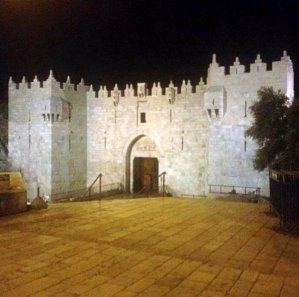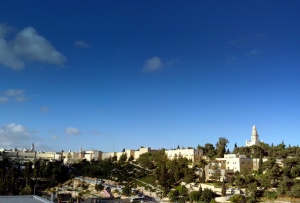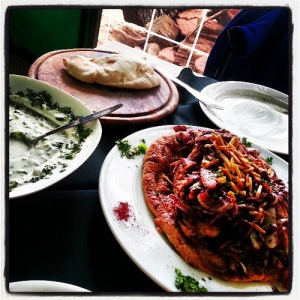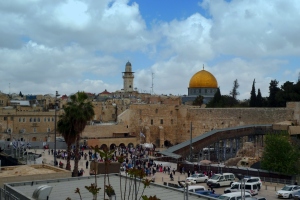The Other Side of Jerusalem
While most visitors to Israel will undoubtedly see the highlights in Jerusalem like the famous Western Wall and the Church of the Holy Sepulchre in Old Town, not as many will venture further afield to explore the areas outside the main tourist attractions, in particular beyond the “Green Line” of HaShalom Street in what is known as East Jerusalem, center of Palestinian life in the city. As a true example of a treasure off the beaten track, however, a visit to East Jerusalem may be highly worthwhile, as it can provide a glimpse into the current dynamics of Israeli-Palestinian relations, an introduction to Palestinian culture and an insight into individual identities contested along geopolitical and religious boundaries. So no better way to start such exploration than to visit Damascus Gate along the walls of Old Town. To reach the gate, we are already crossing the former border, where between 1948 when Israel was founded and the 6-day war of 1967 East Jerusalem was practically cut off from the rest of the city. As we reach the Damascus Gate, we have an option to enter Old Town and its Muslim Quarter, which has also been the subject of talks on Palestinian self-determination, or head into bustling Salah Ad-Din Street, among the main streets for Palestinians in Jerusalem.

The “other gate”…the Damascus Gate…leading to the Muslim Quarter in Old Town and to Palestinian East Jerusalem on the other side
Walking North along Salah Ad-Din street it is noticeable that most signs are posted in Arabic and many women are veiled. Talking to locals living in this culturally diverse yet divisive environment we gain insights into how identities are continuously contested and as such always tied to the complex geopolitical conflict that has been lingering over Jerusalem ever since Israel’s founding in 1948. So individual acts of resistance to Israeli domination become an integral part in the intricate interactions between self and other for individuals’ daily lives. Such resistance may manifest itself in support for alternative venues such as the EDUCATIONAL BOOKSTORE (19, Salah Ad-Din Street), where considerable literature is available in English on Palestinian self-assertion in Jerusalem and the West Bank. As a venue to educate, enlighten and inform, the Educational Bookstore plays a pivotal role in portraying a rich and balanced account of Otherness in highly contested terrain. Talking to local friends, we hear about individual trajectories between self-doubt, resistance and self-assertion, as feelings of Otherness, being rejected at worst and blindly tolerated at best, become nuances of identities renegotiated in daily interactions with their surroundings. Most Palestinian locals have no access to passports or actual citizenship and must often fight hard for social services that regular Israelis may take for granted.
As we continue our cultural explorations, we venture into the smaller side streets away from Salah Ad-Din Road to enjoy delightful dishes of Palestinian cuisine at the nearby Azzahra Hotel (www.azzahrahotel.com; 13 Azzarah Street, East Jerusalem). Such specialties may include Okra, Mansaf or the delicious chicken dish on Palestinian bread known as Mousakhan. Why not enjoy them with authentic Palestinian beer, the most famous of which is Taybeh? (www.taybehbeer.com) So indulging in the culinary delights of East Jerusalem gives us a further introduction into the notion of Palestinian identities in this perpetually divided city. Yet no act of cultural self-assertion of the locals here is ever complete if not followed by reenacted daily habits in support of self-determination and emancipation. To this end, we find numerous stores throughout East Jerusalem and even immediately beyond that support Palestinian communities by selling embroideries, handicrafts and other artifacts manufactured in the West Bank and occupied territories. It is much needed community and financial support to benefit the very people at the heart of the conflict.
Irrevocably we come up with the question locals struggle with on a daily basis, namely that of how they may envision a solution for a future of peaceful Israeli-Palestinian coexistence. As a result of years of conflict, many locals have turned their back on this hotbed of political and religious conflict and have sought better fortunes abroad. Yet some remain at the forefront of their daily struggles for autonomy, respect and self-determination. And many say that a solution is as far removed as it has ever been and some naive child-like approach may be needed in finding a compromise that allows peaceful coexistence for Israelis and Palestinians alike. Locals here are already in a fragile state of coexistence, yet according to rules formulated by the occupying forces that the occupied must adhere to. Why not, many East Jerusalem locals wonder, grant Palestinians here greater self-autonomy, civic freedoms and rights and simply call the country Israel-Palestine as a true example of peaceful, respectful coexistence? It will no doubt take many generations of visionaries, idealists and peaceful activists to work tirelessly towards making such a vision a reality here.





Comments
Post a Comment